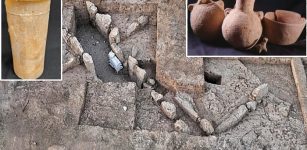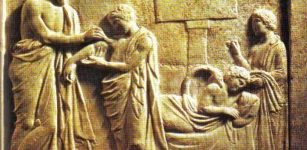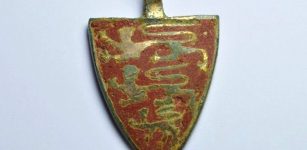Massive Head Of Hercules Pulled From The Antikythera Shipwreck
Jan Bartek - AncientPages.com - While exploring the historic Roman-era shipwreck off the islet of Antikythera marine archeologists discovered several ancient artifacts recovered from the seafloor. The most eye-striking underwater discovery was a massive head. The greater-than-life-size marble head of a man with a beard has been identified as the mythological hero Hercules, one of the best-known heroes in Greek and Roman mythology.
An archaeologist assesses the possible Hercules head. Credit: photo by Nikos Giannoulakis, courtesy the Return to Antikythera Project.
Divers also discovered, “a marble plinth for a statue along with remaining portions of its lower legs, nails, a lead collar for an anchor, and two human teeth. The findings reveal that there are many archaeological treasures yet to be discovered off the coast of Greece — and at dozens of other underwater sites across the Mediterranean,” the Hyperallergic reports.
All objects have been transferred to the Ephorate of Underwater Archaeology for conservation.
The new excavations are part of a multi-year (2021–2025) project led by the Swiss School of Archaeology in Greece, the Ephorate of Antiquities of Euboea, and the Ephorate of Underwater Antiquities under the direction of Angeliki Simosi and Lorenz Baumer.
Ever since the discovery in 1900, by a Greek sponge diver named Elias Stadiatis, the Antikythera wreck dating to around 60 B.C has long fascinated scientists and enthusiasts. The shipwreck became world famous because of the so-called Antikythera mechanism, recovered from the wreckage. The Antikythera mechanism might be the world's oldest analog computer.
The headless “Farnese” type Hercules housed at the National Archaeological Museum. Credit: Gary Todd - CC0 1.0
Scientists say the ancient Greek astronomical calculator known as the Antikythera Mechanism, a hand-powered mechanical device was used to predict astronomical events. The Antikythera Mechanism is the most complex piece of engineering to have survived from the ancient world. The 2,000-year-old device was used to predict the positions of the Sun, Moon, and the planets as well as lunar and solar eclipses.
Credit: Greek Culture Ministry/via AMNA
The astronomical calculator is a bronze device that consists of a complex combination of 30 surviving bronze gears used to predict astronomical events, including eclipses, phases of the moon, positions of the planets and even dates of the Olympics. The object contains thousands of text characters hidden inside the fragments, unread for nearly 2,000 years. Inscriptions on the back cover include a description of the cosmos display, with the planets moving on rings and indicated by marker beads.
Antikythera mechanism. Credit: Credit: Media Viewer - CC BY 2.5
Two critical numbers in the X-rays of the front cover, of 462 years and 442 years, accurately represent the cycles of Venus and Saturn respectively. When observed from Earth, the planets’ cycles sometimes reverse their motions against the stars. After many years, scientists say they have solved the mystery of the Antikythera mechanism.
See also: More Archaeology News
The Antikythera mechanism, and 36 marble sculptures (representing Hercules, Ulysses, Diomedes, Hermes, and Apollo, among others); a bronze statue dubbed "The Philosopher" (circa 340 BCE); a bronze lyre; pieces of glasswork; and three marble horse statues, all recovered from the shipwreck are now housed in the National Archaeological Museum of Athens.
Written by Jan Bartek - AncientPages.com Staff Writer
























